Pathogen Challenge and Dietary Shift Alter Microbiota Composition and Activity in a Mucin-Associated in vitro Model of the Piglet Colon (MPigut-IVM) Simulating Weaning Transition
- PMID: 34349744
- PMCID: PMC8328230
- DOI: 10.3389/fmicb.2021.703421
Pathogen Challenge and Dietary Shift Alter Microbiota Composition and Activity in a Mucin-Associated in vitro Model of the Piglet Colon (MPigut-IVM) Simulating Weaning Transition
Abstract
Enterotoxigenic Escherichia coli (ETEC) is the principal pathogen responsible for post-weaning diarrhea in newly weaned piglets. Expansion of ETEC at weaning is thought to be the consequence of various stress factors such as transient anorexia, dietary change or increase in intestinal inflammation and permeability, but the exact mechanisms remain to be elucidated. As the use of animal experiments raise more and more ethical concerns, we used a recently developed in vitro model of piglet colonic microbiome and mucobiome, the MPigut-IVM, to evaluate the effects of a simulated weaning transition and pathogen challenge at weaning. Our data suggested that the tested factors impacted the composition and functionality of the MPigut-IVM microbiota. The simulation of weaning transition led to an increase in relative abundance of the Prevotellaceae family which was further promoted by the presence of the ETEC strain. In contrast, several beneficial families such as Bacteroidiaceae or Ruminococcaceae and gut health related short chain fatty acids like butyrate or acetate were reduced upon simulated weaning. Moreover, the incubation of MPigut-IVM filtrated effluents with porcine intestinal cell cultures showed that ETEC challenge in the in vitro model led to an increased expression of pro-inflammatory genes by the porcine cells. This study provides insights about the etiology of a dysbiotic microbiota in post-weaning piglets.
Keywords: ETEC; gene expression; in vitro model of colonic microbiota; intestinal cells; piglet; weaning.
Copyright © 2021 Gresse, Chaucheyras-Durand, Garrido, Denis, Jiménez-Marín, Beaumont, Van de Wiele, Forano and Blanquet-Diot.
Conflict of interest statement
FC-D and RG are employees of Lallemand SAS. The authors declare that this study received funding from Lallemand SAS. The funder had the following involvement in the study: study design, data analysis, interpretation of the data and writing of the article. The remaining authors declare that the research was conducted in the absence of any commercial or financial relationships that could be construed as a potential conflict of interest.
Figures

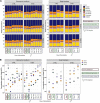

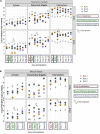
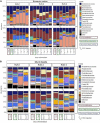
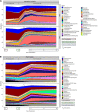
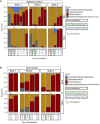

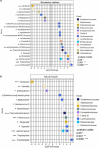

Similar articles
-
Saccharomyces Cerevisiae Var Boulardii CNCM I-1079 Reduces Expression of Genes Involved in Inflammatory Response in Porcine Cells Challenged by Enterotoxigenic E. Coli and Influences Bacterial Communities in an In Vitro Model of the Weaning Piglet Colon.Antibiotics (Basel). 2021 Sep 11;10(9):1101. doi: 10.3390/antibiotics10091101. Antibiotics (Basel). 2021. PMID: 34572682 Free PMC article.
-
Weaning-associated feed deprivation stress causes microbiota disruptions in a novel mucin-containing in vitro model of the piglet colon (MPigut-IVM).J Anim Sci Biotechnol. 2021 Jun 2;12(1):75. doi: 10.1186/s40104-021-00584-0. J Anim Sci Biotechnol. 2021. PMID: 34078434 Free PMC article.
-
Dietary fermented soybean meal replacement alleviates diarrhea in weaned piglets challenged with enterotoxigenic Escherichia coli K88 by modulating inflammatory cytokine levels and cecal microbiota composition.BMC Vet Res. 2020 Jul 14;16(1):245. doi: 10.1186/s12917-020-02466-5. BMC Vet Res. 2020. PMID: 32664940 Free PMC article.
-
Response of gastrointestinal fermentative activity and colonic microbiota to protected sodium butyrate and protected sodium heptanoate in weaned piglets challenged with ETEC F4.Arch Anim Nutr. 2019 Oct;73(5):339-359. doi: 10.1080/1745039X.2019.1641376. Epub 2019 Jul 25. Arch Anim Nutr. 2019. PMID: 31342760
-
Methodology and application of Escherichia coli F4 and F18 encoding infection models in post-weaning pigs.J Anim Sci Biotechnol. 2019 Jun 13;10:53. doi: 10.1186/s40104-019-0352-7. eCollection 2019. J Anim Sci Biotechnol. 2019. PMID: 31210932 Free PMC article. Review.
Cited by
-
Saccharomyces Cerevisiae Var Boulardii CNCM I-1079 Reduces Expression of Genes Involved in Inflammatory Response in Porcine Cells Challenged by Enterotoxigenic E. Coli and Influences Bacterial Communities in an In Vitro Model of the Weaning Piglet Colon.Antibiotics (Basel). 2021 Sep 11;10(9):1101. doi: 10.3390/antibiotics10091101. Antibiotics (Basel). 2021. PMID: 34572682 Free PMC article.
-
A short-term bioreactor assay to assess the effect of essential oils on a microbiota derived from piglet's intestinal content.Acta Vet Scand. 2023 May 19;65(1):17. doi: 10.1186/s13028-023-00679-w. Acta Vet Scand. 2023. PMID: 37208761 Free PMC article.
-
Animal and In Vitro Models as Powerful Tools to Decipher the Effects of Enteric Pathogens on the Human Gut Microbiota.Microorganisms. 2023 Dec 29;12(1):67. doi: 10.3390/microorganisms12010067. Microorganisms. 2023. PMID: 38257894 Free PMC article. Review.
-
The Role of Gut Microbiota in the Progression of Parkinson's Disease and the Mechanism of Intervention by Traditional Chinese Medicine.Neuropsychiatr Dis Treat. 2022 Jul 26;18:1507-1520. doi: 10.2147/NDT.S367016. eCollection 2022. Neuropsychiatr Dis Treat. 2022. PMID: 35923300 Free PMC article. Review.
-
Impact of Bacillus cereus on the Human Gut Microbiota in a 3D In Vitro Model.Microorganisms. 2023 Jul 17;11(7):1826. doi: 10.3390/microorganisms11071826. Microorganisms. 2023. PMID: 37512998 Free PMC article.
References
-
- Barba-Vidal E., Castillejos L., López-Colom P., Rivero Urgell M., Moreno Muñoz J. A., Martín-Orúe S. M. (2017). Evaluation of the probiotic strain Bifidobacterium longum subsp. Infantis CECT 7210 capacities to improve health status and fight digestive pathogens in a piglet model. Front. Microbiol. 8:533. 10.3389/fmicb.2017.00533 - DOI - PMC - PubMed
LinkOut - more resources
Full Text Sources
Research Materials

